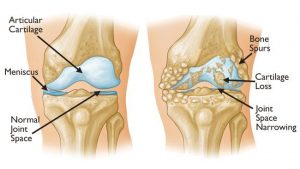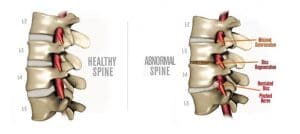What Can Be Done About Degenerative Arthritis
Some of the common questions we get as physical therapists are “How can physical therapy help with arthritis?” or “You can’t do anything about arthritis right?”
The good news is, there are research proven things that we as physical therapists can do to help with arthritis. Let’s first start with some science explaining what arthritis is.
Worn Down Spongy Stuff
 Osteoarthritis is when the spongy stuff between your bones (hyaline cartilage and/or fibrocartilage) wears down. As this occurs the bones move closer together which results in ligaments, that connect the bones, going on slack. This slack allows the bones to slide around more which creates greater wear and tear. We call this “degenerative instability,” which is part of the “degenerative cycle” or “degenerative process.”
Osteoarthritis is when the spongy stuff between your bones (hyaline cartilage and/or fibrocartilage) wears down. As this occurs the bones move closer together which results in ligaments, that connect the bones, going on slack. This slack allows the bones to slide around more which creates greater wear and tear. We call this “degenerative instability,” which is part of the “degenerative cycle” or “degenerative process.”

The good news is many people who are walking around with worn out “spongy stuff” don’t have pain. Multiple research studies have shown the degenerative breakdown of cartilage in a joint or the spine doesn’t equal pain and disability. So, the question becomes, “how can we get your arthritic joint/spine, that is currently inflamed and irritated, back to being pain-free?”
The Big Three
Three things we focus on in physical therapy when treating osteoarthritis or degenerative issues are:
- Reducing pain/inflammation
- Restoring range of motion
- Strengthening/movement re-education exercise
Reducing Pain and Inflammation
Ways we reduce pain and inflammation:
- Drugs. Take an anti-inflammatory, as long as approved by your primary care physician.
- Cold/hot therapy. Cold reduces swelling and inflammation and heat increases circulation.
- Taping/bracing. All of our 16 locations have physical therapist’s trained in Kinesiology Taping or Rock Taping. This tape or a simple brace from the pharmacy can help take pressure off an arthritic joint/area and assist muscles in supporting the joint better.
- Dry needling. All of our clinics have physical therapist’s certified in dry needling. Dry needling is the use of fine needles (similar to acupuncture needles) to calm down the central nervous system, stimulate blood flow and reduce pain.
Restoring Range of Motion
If you have had arthritis in an area for years you will often lose range of motion or flexibility of that joint. All of our physical therapists at Hulst Jepsen Physical Therapy are trained in manual therapy and are skilled at helping restore mobility to that joint/spinal segment through soft tissue and/or joint/spine mobilization techniques.
Strengthening and Movement Re-Education
Studies have shown that strengthening exercise is the most important thing you can do to treat arthritis. Here are some reasons why strengthening exercise is key:
- Muscles are joint/spine shock absorbers, protectors and stabilizers. The tissues protect your spongy stuff more than any other are the muscles that support and stabilize that joint. Core muscles stabilize and protect your spinal discs. The quadriceps (thigh muscles) protect your knee meniscus and hyaline cartilage on the end of your knee bones. The gluteus medius and maximus stabilize and protect your hip joint. Muscles are your number one weapon in unloading and protecting a degenerated area.
- Motion is lotion. This phrase has been in the physical therapy world for decades and has always been one of my favorites. Motion is lotion for your spongy stuff. What it means is our joint cartilage (spongy stuff), which lacks blood supply, gets its nourishment from the fluid in the joint (synovial fluid) as that fluid moves in and out of the cartilage. So, the worst thing you can do for your spongy stuff is not move. Exercise gets that joint moving fluidly and helps keep your spongy stuff healthy.
- Research says so. Along with anti-inflammatories, research supports exercise as the most effective treatment for arthritis. The nice thing about exercise is there are no side effects compared to popping pills.
Myth – “No Pain, No Gain”
I have had many patients over the years with arthritis/degenerative issues tell me they tried exercise and it only made things worse. The key is targeting the key muscle groups with exercise without increasing joint inflammation. This is why you need a skilled physical therapist to help run you through a safe exercise progression.
Sometimes Low-Impact is Needed
Recently I had a woman with hip arthritis who limped into the clinic and stated she walks two miles per day for exercise even though it hurts. I immediately encouraged her to stop walking for exercise and start using a stationary bike as that produces lower impact forces on her hip joint.
In conclusion, not only is there much that can be done for arthritis, our highly educated and skilled crew of Doctors of Physical Therapy at Hulst Jepsen Physical Therapy are the perfect health professionals to give you the highest level of hands-on, personalized care. I know our crew can help you live a more pain-free life … even with arthritis.
Image Sources:
orthoinfo.aaos.org/en/diseases–conditions/arthritis-of-the-knee/
nextlevelhealth.com/services/spinal-care/
